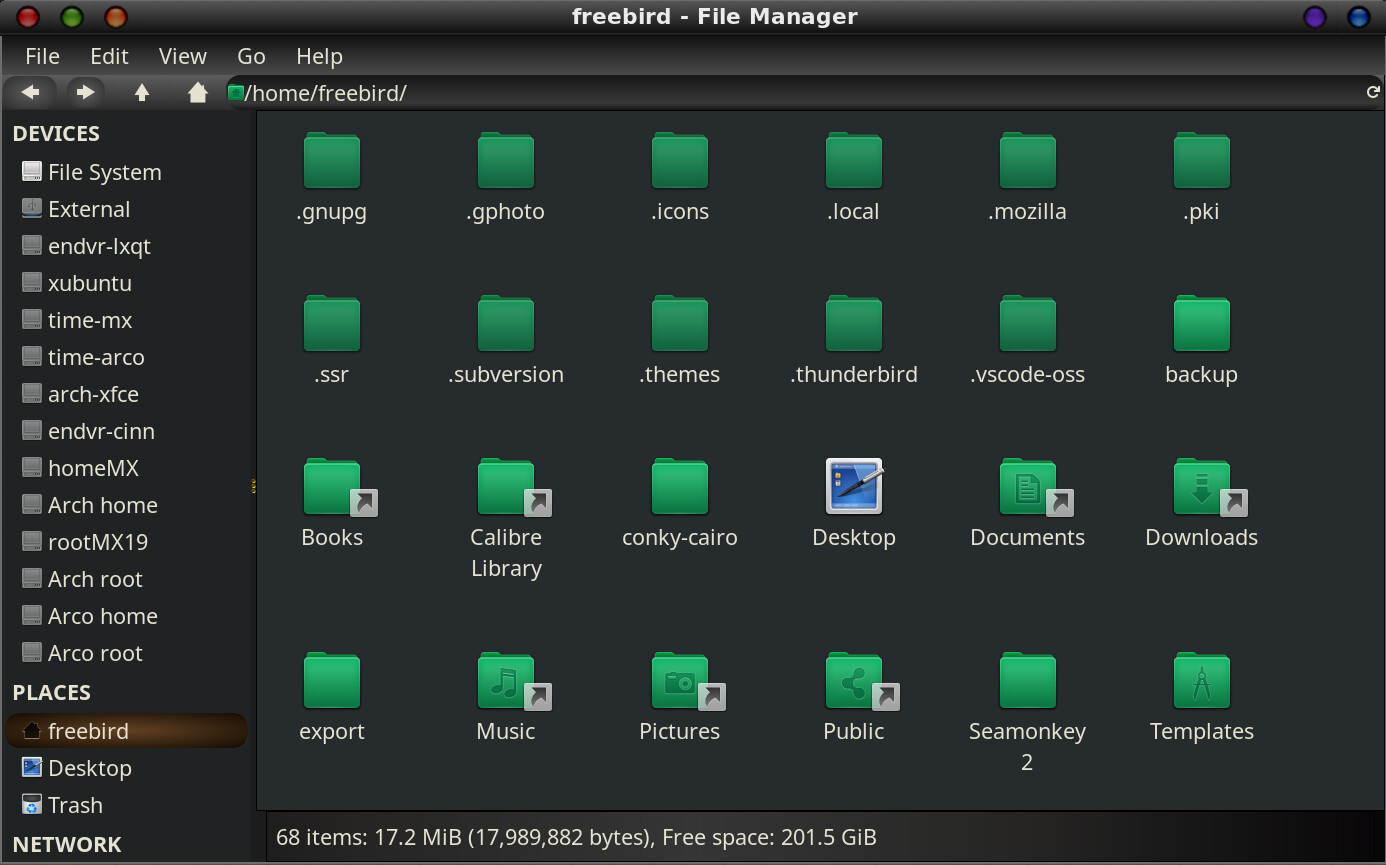Hi,
My new NVMe SSD has just been delivered! Yay!
I want to migrate my existing installations of EndeavourOS and Ubuntu to the new disk.
Is it better to install EndeavourOS from scratch and then migrate user directories and the install apps etc as required,
or would copying partitions from the existing hard disk to the new disk work?
There are a bunch of ext4 partitions and one btrfs partition.
There is always a way to do ANYTHING on Linux, but which is easiest/most effective is not always as obvious. For one thing, size matters - how big is what is to be ‘moved’? How large is the m.2 disk? How many partitions are involved here, and do they all move?
Possibilities that come to my mind quickly include setting up the partitions, and rsync’ing them across - or ensuring they match in size, and dd’ing them across - or (what I would probably do) - make sure things are backed up with TImeshift, reinstall to the best setup you know of (partition-wise) and then restore your current setup to the new install.
I’m sure there are more ways - and perhaps others have better ideas (probable) but to me the reinstall/timeshift seems like the surest way NOT to mess up and lose stuff (dd has an annoying habit of doing what you tell it, not what you meant ![]() )
)
Freebird54
many many ways to do this… clonezilla dd e.t.c. but mostly needs some changes to work fully afterwords like uuid’s for partitions
Thanks.
I did some reading up and I will probably I use e2image for ext4 partitions.
btrfs has send and receive so I might just give that a shot.
@joekamprad yes if I copy images I will have to change uuids as well as matching fstab entries.
The bit that I am not sure about is the /boot/efi partition.
After “copying” the partitions I think I can boot in the systemrescue usb and from there to the EndeavourOS partition copied to the nvme.
After that I’m hoping that
grub-mkconfig -o /boot/grub/grub.cfg
grub-install --target=x86_64-efi --efi-directory=/boot/efi --bootloader-id=EndeavourOS
will fix things.
You could bypass grub entirely if you wanted - rEFInd for instance will direct boot your kernel, meaning you don’t need grub to get going. We have a wiki entry on it now (cough, cough) if you’re not familiar with it… ![]()
Freebird54
Finally someone with intelligence. rEFind is the way to go Grub is just so so yesterday. ![]()
You only need a EFI partition of 200 MB.
https://www.rodsbooks.com/refind/installing.html
https://wiki.archlinux.org/index.php/REFInd
![]()
You left one out… ![]()
https://endeavouros.com/docs/installation/how-to-install-refind/
And there’s more on the end of it, too
I just run refind-install script and without any efforts on my part it allows me to boot into linux, bsd and grub ![]() The names of the entries are wrong, but I guess it is configurable.
The names of the entries are wrong, but I guess it is configurable.
I wonder why I was torturing myself with grub configuration…
edit: well, I should probably say non-intuitive as to the entries names rather than wrong
Thank you for the wiki, @freebird54 ![]()
Yeah - it’s amazing what it’ll do on its own. You might want to check on the microcode front if you have an Intel or an AMD processor though. Arch-based distros like to add it in the boot process as described in the wiki - but at least it’s a one-time config in the auto-generated conf file co-located with the kernel files… one thing rEFInd skips!
Forgot to mention, if you give the filesystems and partitions descriptive names, they get used by rEFInd as it goes… so I get entries like vmlinuz on endvr-cinn or the equivalent. Makes things clearer, especially until you get the logos sorted out!
So, I should rename the partition itself? For my bsd bootloader it says “Boot Fallback boot loader from EFISYS” for example… I mean it is descriptive if you know what’s about, but yeah. In GRUB it seemed somewhat easier as it just uses the name of the menuentry and an icon associated with the class. But I am a newbie to all this to be honest and after the things worked after initial install script I did nothing to make it better ![]()
As long as you know what you’re looking at, then that is the main thing. If you’re guessing ![]() - then I recommend tidying it up! Here’s a sampling of what I run on this system:
- then I recommend tidying it up! Here’s a sampling of what I run on this system:
/dev/nvme0n1p1: UUID="C3B1-5E71" BLOCK_SIZE="512" TYPE="vfat" PARTLABEL="efi"
/dev/nvme0n1p2: LABEL="Arco root" UUID="XXXXXXXX-XXXX-XXXX-XXXXXXXXXXXX" BLOCK_SIZE="4096" TYPE="ext4"
/dev/nvme0n1p3: LABEL="Arco home" UUID="XXXXXXXX-XXXX-XXXX-XXXXXXXXXXXX" BLOCK_SIZE="4096" TYPE="ext4"
/dev/nvme0n1p4: LABEL="Endvr root" UUID="XXXXXXXX-XXXX-XXXX-XXXXXXXXXXXX" BLOCK_SIZE="4096" TYPE="ext4"
/dev/nvme0n1p5: LABEL="Arch root" UUID="XXXXXXXX-XXXX-XXXX-XXXXXXXXXXXX" BLOCK_SIZE="4096" TYPE="ext4"
/dev/nvme0n1p6: LABEL="rootMX19" UUID="XXXXXXXX-XXXX-XXXX-XXXXXXXXXXXX" BLOCK_SIZE="4096" TYPE="ext4"
/dev/nvme0n1p7: UUID="XXXXXXXX-XXXX-XXXX-XXXXXXXXXXXX" TYPE="swap" PARTLABEL="swap"
/dev/sda1: LABEL="Endvr home" UUID="XXXXXXXX-XXXX-XXXX-XXXXXXXXXXXX" BLOCK_SIZE="4096" TYPE="ext4"
/dev/sda2: LABEL="Arch home" UUID="XXXXXXXX-XXXX-XXXX-XXXXXXXXXXXX" BLOCK_SIZE="4096" TYPE="ext4"
/dev/sda3: LABEL="homeMX" UUID="XXXXXXXX-XXXX-XXXX-XXXXXXXXXXXX" BLOCK_SIZE="4096" TYPE="ext4"
/dev/sda4: LABEL="endvr-cinn" UUID="XXXXXXXX-XXXX-XXXX-XXXXXXXXXXXX" BLOCK_SIZE="4096" TYPE="ext4"
/dev/sda5: LABEL="arch-xfce" UUID="XXXXXXXX-XXXX-XXXX-XXXXXXXXXXXX" BLOCK_SIZE="4096" TYPE="ext4"
/dev/sdb1: LABEL="Data" UUID="XXXXXXXX-XXXX-XXXX-XXXXXXXXXXXX" BLOCK_SIZE="4096" TYPE="ext4"
/dev/sdb2: LABEL="time-endvr" UUID="XXXXXXXX-XXXX-XXXX-XXXXXXXXXXXX" BLOCK_SIZE="4096" TYPE="ext4"
/dev/sdb3: LABEL="time-arco" UUID="XXXXXXXX-XXXX-XXXX-XXXXXXXXXXXX" BLOCK_SIZE="4096" TYPE="ext4"
/dev/sdb4: LABEL="time-mx" UUID="XXXXXXXX-XXXX-XXXX-XXXXXXXXXXXX" BLOCK_SIZE="4096" TYPE="ext4"
/dev/sdb5: LABEL="xubuntu" UUID="XXXXXXXX-XXXX-XXXX-XXXXXXXXXXXX" BLOCK_SIZE="4096" TYPE="ext4"
/dev/sdb6: LABEL="endvr-lxqt" UUID="XXXXXXXX-XXXX-XXXX-XXXXXXXXXXXX" BLOCK_SIZE="4096" TYPE="ext4"
This is the output of sudo blkid. I blanked UUID’s and threw away the PARTLABEL part, but it gives a pretty good idea of what I have where on here at the moment, right? Oh - and the time-mx and the like are timeshift partitions, just in case. It also makes a difference with your file manager - here’s Thunar, same system:

That’s the main reason I do this - a whole row of “200 gb Filesystem” entries can drive you nuts!
The easiest way to achieve your label plans is to fire up GParted, and use it to make changes on all the UNMOUNTED (not in use on system you’re in) drives – and then to boot an alternate system, and run GParted from there to finish off.
It may never come up - but I am happy I bothered every time I need something from one of the other distros on here!
It also shows up at boot in rEFInd, of course.
I see, thanks. I don’t have so much stuff, so it’s not hard to figure out what to boot and I don’t usually bother with labels ![]()
Where can I find this icon theme? ![]()
Not sure which ‘look’ site I got it from (Gnome-look or xfce-look) but it’s called Delft - and is a very complete icon set with lots of colours (Amber, Aqua, Blue, Dark, Grey, Green, Mint, Purple, Red, and Teal. All have ‘plain’, Dark, Darker and Darkest variants.). It is also available from the AUR, (yay Delft). It was built from Faenza - but with up-to-date app coverage, or so it says!
Oh - and with the labels - you can see how they work with rEFInd in the sceenshots of the wiki entry on installing it ![]()
@freebird54
I just reinstalled rEFInd on EndeavourOS Xfce which is on one nvme disc. I have EndeavourOS Cinnamon on another nvme disc and Windows on an SSD. So i copied the endeavour logo over in xfce and both have the same log. I want to give Cinnamon it’s own logo. How does it differentiate the two so not using the same logo? I also want to name them. Do i label the partitions?
Edit: Currently have two endeavouros logos and the Windows logo.
Just copy the logo you want to use to vmlinuz-linux.png in the same directory you’re booting from. Here’s an XFCE logo I used in the ‘case study’ on the wiki…
which is one way out of the confusion ![]() I’ve found ‘official’ logos for most on the web - usually in commons…
I’ve found ‘official’ logos for most on the web - usually in commons…

Edit: - and the cinnamon!
@freebird54
What i would like to do is get this down pat so i understand it. I’m not sure how to set this up as i have two 500 GB nvme drives and a 500 GB SSD and a 4 TB hard drive. I would like to have more but i also don’t want to see a bunch of drives.(partitions)
So i have to boot into cinnamon and put the logo on that drive? in the folder where the vmlinuz file is?
Too many factors to give too much advice about - but I would tend to prioritize by speed/frequency of access. To keep the partition count down, I would install each system on as a /root on an nvme drive (efi on the first one) - use the SSD for fast access data (maybe Videos, Pictures if you work with them a lot) and the rest of the Data (like Music and so on) on the spinner. You can soft link to the data from all the distros to keep things simple, and to make data backup simple too.
I am on 1 nvme 256gb, 1 SSD 1tb, and 1 spinner (4tb) and that’s what I’d do if doing it again! (split the early ones into /root and /home - but I don’t need the split with all the data outside /home…)